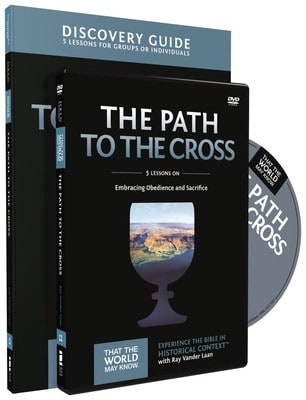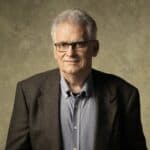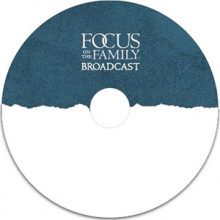(Sound of Middle Eastern music and crowds)
John Fuller: Well, it’s been about 3,000 years since the children of Israel made their exodus out of Egypt and God is still inviting each one of us today to understand what that meant for them and what it means to experience Him and worship Him. And that’s what we’re gonna be talking about on today’s “Focus on the Family,” with your host, Focus president, Jim Daly. I’m John Fuller and today, well-known historian and Bible teacher, and our good friend Ray Vander Laan, is our guest.
Jim Daly: John, I am very enthusiastic to hear the teaching that Ray delivers so wonderfully from the Scriptures. He peels it back and gives us insights that we don’t see on the surface. That’s what makes his teaching so powerful. And I have used his DVD series, That the World May Know in so many different ways, whether it’s in the morning early or in the evening on the treadmill, watching it or talking with my boys about it and letting them hear it and listen to it and then having some discussion about it. He does an incredible job of showing us the artifacts, the ruins, the metaphors that are spoken there and what they mean for us today. It is wonderful teaching that I want everybody to get ahold of.
John: And I hope that if you’ve not seen the DVD series, That the World May Know, that you’ll go online and find out more and perhaps do what our Sunday school is doing, that is look at these as a group and talk about ’em and learn from Ray. And Ray’s been a Bible teacher for about 40 years. He’s currently teaching at Holland Christian High School in Holland, Michigan. Actually he’s been doing that for about 25 years. As a seminarian, he studied in Israel, so he’s got real deep knowledge about Jewish history and tradition. And he says, if you can make the Bible exciting and applicable to high school seniors, then you can teach just about anyone.
Ray’s been doing that very thing for all these years and it’s our privilege to have him share the Bible as a story and invite you to join in on the experience, as we listen to this recorded conversation a while back with Ray Vander Laan on today’s “Focus on the Family.”
Jim: For those listeners that don’t know the background on the That the World May Know series, this started back in the early 90s. You hosted, I believe, Ed and Elsa Prince–Elsa’s one of our board members—along with Jim and Shirley Dobson, and I’m sure a host of other people, to go to the Holy Land and to actually see what we’re talking about. And talk about that story, what happened there.
Ray Vander Laan: Well, it was really quite an amazing story, because Ed and Elsa Prince invited me to lead a trip of their friends for one of Elsa’s birthdays. And I didn’t know Ed and Elsa Prince very well at all and agreed to do that, only to discover that quite a number of Focus people were on the trip, including Dr. and Mrs. Dobson (Chuckling).
And we had raised our kids on Dobson and I remember the stunned feeling when I discovered, “Wow! What is God doing with my life?”
Jim: Hm.
Ray: But when we got there, this was a group of people with intense passion for God, but also the vision for the fact that what they were studying was something that had real value for Christians around the world, particularly for Christian families. And the third day of that trip at Megiddo–Armageddon, no less–Dr. and Mrs. Dobson sat with my wife, Esther and me at lunch and said, “Would you be interested in putting this on video so that we can distribute it to a wider audience?”
Well, I was so naïve, I’d never been involved in anything like that before. I imagined a small video of some kind. But that was 1993.
Jim: And these are little 20, 25-minute teaching opportunities, where you illuminate these massive themes that you’re talking about. This is heady material, you know, the resurrection of Christ. And the way you unfold it, Ray, it’s fascinating, because you take what Jesus and what they were talking about in the Old Testament and the New Testament–the broom tree is an example and the significance of that–and it just helps illuminate for people the Scripture and the narrative.
When you’re going back to the ’90s, when you first thought about this project, what was your goal? What were you trying to accomplish?
Ray: Well, I think I realized that God had entrusted to me as a Bible teacher, a certain set of content, a certain way of understanding the biblical world that I had learned through Jewish eyes. And in the Eastern world, it’s more common to present truth in the package of a story or a picture or a metaphor. So, I had stressed understanding the story in its context or recognizing the metaphors that the writer is using and how they would’ve been understood by that original audience, as adding nuance to it.
So, I think my goal was to create a resource that parents, that Christian teachers, that Bible-study groups could use, to learn the contextual setting, or maybe learn the text—the Bible text—in its contextual setting. I had no dream, no vision of where God was gonna take this thing. I never imagined how God would use this, but that was believed God had entrusted to me.
Jim: Do you have an illustration that really can grab the listener out there. Someone’s driving along in a car, trying to track with our conversation right now. I mentioned the broom tree a moment ago. Is there an illustration that can really capture people and help them understand what it is you’re discussing?
Ray: Well, I think there are a number of ways to do that. One would simply be, to notice how often profound religious things are described in ordinary language. So, Jesus is the bread of life. And you suddenly discover, bread has a smell. It has a delightful taste. It has a life-giving reality to it and so, it’s a way of describing biblical truth in figures that are experiential, as well as intellectual.
But let me give you one example. Jesus makes an odd statement, I think, if you just read it in one of His teachings. He said there was a woman who took 65 pounds of flour and mixed yeast into it.
Jim: (Chuckling) That’s a big ball—
Ray: Now—
Jim: –of dough.
Ray: –I had never even thought about that.
John: Hm.
Ray: Three measures, it says. Scholars debate whether it’s 50 to 75 pounds. Let’s just say 65. How would a woman make 65 pounds of flour and why? And it never dawned on me until a Jewish friend of mine and I were talking. And I said, “You know, Jesus made this unusual reference to a woman with 65 pounds of flour. And he looked at me with this look on his face of “startlement.” He looked startled. And I said, “What?” And he said, “That comes out of Jesus’ Bible [sic], the Old Testament.” And I said, “Where?” And he said, “Well, read the story of Abraham.”
Abraham is sitting in the shade of the tent. Here came three strangers. He didn’t know who they were. Turns out it’s God and two angels. But he didn’t know who they were. He immediately got up, this old man and did a[n] undignified thing in the culture. He ran out to meet the strangers, washed their feet, invited them in—insisted that they come in—and he said to Sarah, “Take the finest flour—65 pounds of it—and bake bread.”
And the Jewish thinker said, “Look at this man who cared so deeply about strangers, that not only did he invite them in, but he made more bread than they could eat in a month–
Jim: Hm.
Ray: –just to make sure they got absolutely enough. And not only that, but Sarah couldn’t have made that much bread unless a miracle of God happened. So, the Jewish understanding when Jesus said that was, that the Abraham story not only displayed what God’s people’s attitude should be toward people in need, but it indicated that if you care that deeply for people in need, God would miraculously provide.
Jim: Hm.
Ray: So, when Jesus said, “The kingdom of heaven is like a woman who took 65 pounds of flour,” his audience not only heard that and saw the image, but they immediately caught, “Wow! That started with the Abraham story.”
John: Hm.
Ray: Jesus is saying, “The kingdom of heaven is a continuation of what started with Abraham.” And it’s that kind of awareness of story and of metaphor, I think that from the Jewish point of view, is the heart of the Scripture.
Jim: Well, and Ray, that is exactly what excites me. John, I mean, this is the thing I think everyone should be picking up the series That the World May Know. And I don’t mean this as an infomercial. This is the information that helps give contour and context to our faith. And that’s one illustration, but each episode and each lesson is filled with these kind[s] of teaching moments. And Ray, you’ve done a beautiful job—
Ray: Thank you.
Jim: –in illustrating that to the viewer.
Ray: Thank you.
Jim: And I would again, I’ll just do it right here, John. If you don’t have That the World May Know, go to the website and pick it up. And we’re gonna get into more stories now. Talk about sets 8, 9 and 10, that were filmed in Egypt.
Ray: It’s been an interesting history and maybe I could share just a short personal note here. When we finished the last one, I thought that was it. I thought God was finished with me with regard to this part of my life. And then, I went through a desert. In the biblical world, desert is a hard, harsh, difficult place and therefore, becomes a metaphor for life’s tough times.
It was discovered that I had coronary artery disease and had, had a heart attack and I went through a heart bypass. And I went through a real time of struggle. My life was being blessed. My ministry was being blessed. Why now? Why me?
John: What year was that, Ray?
Ray: That was in ’05 [2005]. It was the spring of ’05.
John: We had the staff here praying for you during that time.
Ray: Right. Thank you and I appreciate that and in that setting, I was in the desert.
Jim: Uh-hm.
Ray: And I discovered that desert is a place where you can’t make it on your own. I realized that, if God was going to continue to use me, I was gonna need to depend on Him more fully than I ever had, like the Israelites had to do in the desert they were in.
And out of that was born a dream to say, “You know, what? There’s one more piece of this that God would have me do.” I need to share with folks the biblical story of God’s people in the desert.
Jim: Hm.
Ray: And so, I first thought, just a short, maybe four or five lessons about desert themes. You mentioned broom tree. Broom trees are the shade tree of the desert. It’s just a little shrub. It gets four or 5′ high. You sit in it and there’s hardly any shade, but the Middle Easterner knows, it’s just enough shade to keep you alive—
Jim: Hm.
Ray: –so that when the sun goes down a little bit, you can continue on. And when the Bible says, “The Lord is my shade,” it doesn’t mean necessarily that He’ll lower the temperature to 65, that He’s a big oak tree, where you’re now completely comfortable. But God says, “In the tough times of life, I will be just enough—
John: Hm.
Ray: –so you can go another day, another step.” And first, it was gonna be that, but when I got into it, I realized that God’s people were born in the desert. Abraham was a desert man. Moses was a desert man. David spent time in the desert. Jesus spent time in the desert. And I realized, it was far more foundational to what God was doing to reclaim a broken world than what I had realized.
And so, after much prayer and research and study and a continued investigation into the Jewish background of all of this, I felt we needed to start with the Israelites in Egypt and follow them out of Egypt, into the desert for those 40 years and then, pick up as they entered the Promised Land and then, talk about other desert characters like Abraham and Moses and David and Jesus and John the Baptist. And so, it really does the full sweep of the desert theme of the Bible.
Jim: You know, Ray, I’ve had the chance to be in Egypt and to go to the pyramids and to see the incredible technology that was used during that period of time. And one of the things that struck me was the boats that were made for the—
Ray: Uh-hm.
Jim: –Pharaohs. And they discovered, I think, in the late ’50s, a completely preserved ship for the afterlife for one of the Pharaohs. It still had the linen rope—
Ray: Hm.
Jim: –that was used to tighten the wood that was fitted so closely together, that it was watertight. And then, it was tightened further with these linen ropes.
Ray: Uh-hm, uh-hm.
Jim: And everything was preserved in an airtight seal in stone, that they uncovered, I think in the ’50s. And what shocked me was, the level of technology, the craftsmanship of the time. And yet, when I tried to pull that forward to today, you know, you look at what we have in the way of technology. We can go to the moon, you know. I went to the shuttle launch not long ago and watched this magnificent rocket ship—
Ray: Right.
Jim: –and you do. It’s amazing. But what caught me is, that how man’s heart has not changed. We have not invented a pill that provides a new emotion, a new kind of a psychological edge. It’s what God has given us. It’s the basics.
Ray: Uh-hm.
Jim: You have greed and you have lust and you’ve got envy and you’ve got peace and joy–
Ray: Uh-hm.
Jim: –and thankfulness and love. We’ve not been able to create new emotions like that. And it does apply to what you’re saying, isn’t it, that technology around us will change. Take us to Egypt. Take us to that point where the civilization is thriving. The Pharaoh is the Pharaoh and here’s God’s people.
Ray: Well, I think that’s a brilliant way to frame it, because I remember standing at the foot of the pyramids, oh, two, three years ago and reflecting on the fact that, not only were those unbelievable technological developments and they showed abilities really that have not been matched until recently.
And yet, for the Egyptian, they were more than just big buildings. They were bibles, because the pyramids are a picture of the fact that they believed that Pharaoh was God and the shape of the pyramid represents the angle of the rays of the sun. So, they shaped a pyramid that pointed to the fact that when Pharaoh died on earth, he would continue as god in the heavens and his soul would ascend in the rays of the sun on the pyramid.
Jim: Uh-hm.
Ray: And so, I thought to myself, “Here’s one of the most incredible structures that’s ever been built, but it’s more than that. It contains a worldview. It contains a value system that said, ‘This is what’s important. This is what’s meaningful. This is what’s true.'”
God brought His people there. They were nomadic shepherds, really of very little technological ability at all. And God put His Word in a book. And I found myself standing in front of that pyramid asking, “Which will last longer?”
Jim: Uh-hm.
Ray: The gospel of the Egyptians that Pharaoh was God and Pharaoh keeps the universe running? Or what God put first on paper and then, in human hearts, that as you’re suggesting, lives on today and has things to say to speak to the culture and to the technological advances of today? Anyway, so in Egypt, it’s really intriguing. The Egyptians saw life as a struggle between chaos and order.
Jim: Uh-hm.
Ray: The desert is chaos and the fertile Nile Valley is order. And they believed the gods and particularly, “God on Earth, Pharaoh” functioned to keep chaos at bay and to bring order and harmony to life, so, the Nile would flood; the crops would grow; sheep would have lambs; families would have babies and life would be good. So, Pharaoh’s job was to keep chaos away and to bring order.
Now if you think about it, God entered that situation, put His people into what the Egyptians said, “This is order; this is what’s meaningful. This is what’s valuable. This is what you oughta desire.” And God put His people there and said, “Now listen to Me. In the beginning was chaos—the earth was formless and empty. I spoke to the chaos and out of the chaos, I brought order.
Jim: Uh-hm.
Ray: Sin happened and it brought my order–shalom, the Jew says–back into chaos. Now I gotta teach you something. What you think is order here in Egypt is actually chaos, because it’s attributed to the wrong gods and the wrong worldview. So, I’ll tell you what I want.”
And I can’t imagine the first time the Hebrews heard this. The desert to an Egyptian is chaos. Nothin’ grows there. Nothing lives there. And Moses showed up and said, “Hey, folks, I went out into the desert and I met the God of the Universe.”
Jim: Yeah.
Ray: “And He wants you to leave here and go out into the desert to find shalom.”
Jim: Uh-hm.
Ray: And they must have said, “This is insanity. It’s crazy.” But what struck me is how incredibly relevant it is, because the story of the Exodus is really the story of a struggle of two worldviews. What makes life worth living? And who has the authority to decide what’s right and what’s wrong, what brings order and what defeats chaos? And God said, “It’s not the Egyptians gods. Watch Me.”
Jim: Uh-hm.
Ray: “It’s Me. Will you trust Me, that order, that shalom, that meaning and purpose only comes from Me?” And I found myself so often say, “That’s exactly the struggle in my culture.” There are two voices saying, “What is it that makes life meaningful, purposeful and ordered?” Is it evolutionary development? Is it living up to the standards of the Creator God? Is it the self-sacrificing willingness to care about others? Is it the selfish, take for myself whatever I can get? There’s two worldviews.
Jim: And those things, Ray, are no different from 3,000 years—
Ray: Exactly.
Jim: –ago to today. That is—
Ray: Exactly.
Jim: –that is the human heart–
Ray: Exactly.
Jim: –isn’t it? Yeah, you know, again, I think the Lord through marriage, through parenting, there’s so many wonderful metaphors that exist in that. And when you look at Mount Sinai, so we’re not far off the story now, you’re with Moses. Moses has led the Israelites out of Egypt. They’re in the desert and he comes face to face with God on Mount Sinai. Talk about that, in that marriage metaphor—what the Lord was saying in that context.
Ray: In the Jewish mind, God really focused on two things. One was to get Israel out of Egypt. That took Him, well, most scholars would say the plagues lasted a year. In a sense, once that tenth plague came, Israel was out in a day.
But now God had a much bigger issue to deal with and that is, how do I get Egypt out of Israel? Because they had bought into a worldview; they had developed a lifestyle. They had become comfortable. Ezekiel says they were worshiping Egyptian gods. There were things about them that were as pagan as the Egyptians they lived among.
John: They even took reminders of Egypt with them—
Ray: They did.
John: –that the Egyptian people gladly gave them.
Ray: And amazingly, even though their babies had been thrown in the Nile, which meant you almost assume, some of their daughters had to marry Egyptian kids, pagan kids, they wanted to go back. They wanted to go back to that. They were so deeply enmeshed in that Egyptian world, they wanted to go back.
Jim: What was the estimate, just to paint a picture for the listener again, how many people did Moses lead out? A hundred thousand, a million?
Ray: You see estimates that range greatly. Most Evangelical, Conservative Evangelical thought would put it in the area of 2-plus million, so a pretty significant group of people. Some—
Jim: Right.
Ray: –put it a little less than that. To me, the miracles of God, those numbers don’t change the fact that the dividing of the Red Sea and bringing of manna are miraculous, but the numbers are usually put up pretty high. It was a significant group of people.
Jim: Right, that’s the point.
Ray: So, it was huge. Anyway, now God works to get Egypt out of Israel. So, He brings His Hebrew people to the foot of the Mountain of God. To the Jewish mind, what happens next is a wedding. When I first heard that, I was a bit hesitant—the Ten Commandments, part of a wedding? It just didn’t fit the view that, you know, the Ten Commandments are the ethical-moral base of Western Civilization, which they are. The Ten Commandments are the code God desires people to live by.
Jim: Uh-hm.
Ray: But as I unpacked it, first of all, clearly God refers to Israel as His bride. And when they worship idols, it’s adultery. Second, God says, “I will take you,” Exodus 6, “to be My people.” And He uses the Hebrew word which is translated in other places “marriage.” Isaac took Rebecca as wife. And then, Jeremiah says, “Remember how you followed Me like a bride in the desert.” And I began to realize that, for as central as the Ten Commandments are to the moral, ethical base of civilization—and that’s God’s intent—it also was an incredibly intimate time.
So, I thought to myself, if that’s a wedding, it should have the elements of a Jewish wedding. Well, first the bride at a Jewish wedding goes to what’s called mikvah, a ritual bath and she purifies herself to be pure for her husband. God brought Israel to Mount Sinai and the first thing He tells Moses is, “Have the people sanctify and purify themselves.”
Then in a Jewish wedding, you have a huppah. A huppah is a canopy. It represents in the Jewish mind, the covering of God’s wings, God’s arms. But it also represents God’s covering His people at Sinai. And the bride and groom stand under that protective covering. Well, if you read the story, when Israel stood at the foot of Mount Sinai, God covered the mountain with His glory cloud.
Jim: Uh-hm.
Ray: In fact, the Hebrew literally says, “And the people stood beneath the mountain,” as if God said, “I’m gonna cover you.” Then at a Jewish wedding, the bride and groom exchange what’s called ketubah. It’s the marriage contract and in it, they give their marriage vows. Where in my wedding, my wife and I recited the vows to each other, in a Jewish wedding, you exchange a contract, a ketubah. Well, if so, the ketubah of Sinai becomes the Ten Commandments.
Jim: Right.
Ray: And it struck me, for all its valuable uses as the basis of a legal, moral system, from God’s point of view, the Ten Commandments also are wedding vows. And I began to understand why in Orthodox tradition, you dance when the Ten Commandments are read, because this isn’t just a list of “do this and don’t do this.” This is God saying, “I love you.”
Jim: Hm.
Ray: “I still love you. Do you love Me?” And so, I reframed in one of these programs, the Ten Commandments like marriage vows, where God says, “I’m the Lord. First, you shall have no other lovers. Second, you shall not even have pictures of other lovers—no images. Third, keep My name sacred. I’m gonna give you My name in this marriage; honor it. And fourth, I know how busy you are, so I want a date night.”
Jim: (Chuckling)
Ray: “We’ll call it ‘Sabbath.’ I want a day every week that you and I spend intimately together.”
Jim: Uh-hm.
Ray: And then, the rest of the commandments deal with, “Okay, my bride is many in one body, so get along.” But I began to see the Ten Commandments as this moment to dance before the Lord, because God is saying, “I love you. I want to be your husband. Will you be My bride?”
And it dawned on me that the New Testament teaching–that Jesus is the bridegroom; those who believe and follow Him are His bride–is really just a later development of something that God is already beginning to develop in the life of His people–
Jim: Hm.
Ray: –Israel.
Jim: You know, Ray, this is exactly what excites me when I watch it. I mean, John, this is—
John: Great stuff.
Jim: –illumination of what the Scripture’s talking about. And this is the end of day one and I hope that we can keep talkin’. Ray, is that doable?
Ray: That’s very doable.
Jim: And I would again, just encourage folks to go to the www.focusonthefamily.com website. Look for That the World May Know. Just put it in the search engine there and it’ll pop up. But I would encourage people to get one or two or all of the sets that are available right now. This is a great way to talk to your unbelieving friend, your neighbor and for yourself to get a deeper and better understanding of what God is saying to us—not the superficial thing, but really the deep wedding vows that you just talked about, Ray–beautiful illustration about the deeper meaning. So, John, let’s wrap up and let’s come back tomorrow, Ray and pick it up.
John: As always, it’s great to hear from Ran Vander Laan and that conversation was recorded a while back. It’s a privilege to hear from his heart and to bring that to you today. He has unpacked the Scriptures for us and in just a moment or two, I’ll tell you how you can order Set 12 of the series, That the World May Know: Walking with God in the Desert. It’s related to the content we shared today and Jim, it is so neat to see how God continues to use this series in the lives of so many.
Jim: And John, That the World May Know is one of those tools that Ray, of course, and donors like you, have helped us to develop in order to reach people and I’m so grateful that last year alone, over a million people said that Focus on the Family, many of whom would’ve seen That the World May Know, that Focus was able to help strengthen their faith and equip them in a way to reach out to the culture and That the World May Know is one of those great tools that we have for you, to build your faith up, so that you can share it with others.
If God puts it on your heart today to support the work here at Focus, to help us equip those who don’t know the Lord or maybe are just weak in their faith, we would appreciate that help and that’s how we get these things done.
John: Well, yeah, join the partner team here at Focus on the Family and donate and order DVD Set 12, Walking with God in the Desert, which goes deeper into the content that we discussed today and of course, you’ll have all the stunning visual aspects as captured on location in Egypt. Call 800, the letter A and the word FAMILY; 800-232-6459 or visit online at www.focusonthefamily.com/radio . And when you contribute generously to the work here, if God’s really pushing you to do that, we’ll say thank you for supporting our work here by sending a copy of that DVD to you.
Our program was provided by Focus on the Family and on behalf of Jim Daly, I’m John Fuller, thanking you for listening, inviting you back next time for more from our guest, as we help you and your family thrive.





















